Using .TIF files vs JPG files in focus stacking, A comparison
Jan 8, 2016 19:44:26 #
EnglishBrenda wrote:
The difference in the NEF/RAW files, is the file details are dictated by the camera company and not a universal standard, and not the same for each camera within the same company. I don't think it would be too much of a penalty if all the RAW files were standard as well. There isn't much difference in how the camera's work internally, so why not have a standard RAW file and a new Super 16 bit JPEG that produces images almost as good as the standard RAW file but is smaller because of Smart compression. Thanks mawyatt for such detailed information. I am using PS which does accept nef files but I see your point about the advantages of universal files. We also hear a lot about your gun laws, it is a very complicated conundrum and I worry that an answer will never be found.
While on the subject of Smart files, why not have a file that adjust itself to the intended application, adaptive files if you will. These would adapt to whatever use is intended. For example, for displaying on sites like this they would compress down to a small file size. For printing they would adapt to best fit the print size & printer type, for displaying they would adapt for the display size and resolution, and so on.
I see no reason why this can't be done today, other than it requires getting the camera/printer/display folks to agree on a universal format.
The computer you use has many standards that are more complicated than the image files from a camera. SATA, USB, Thunderbolt, HDMI, Displayport, PCI, and so on. Heck the camera folks already do a good job of using standard SD and CF memory cards, so why not a file standard. JPEG has probably been around longer than CF or SD cards, maybe even DVD!!
But for this to happen it must be done in the camera and not post processed like GIF, PNG, BMP and so on.
Jan 8, 2016 22:05:47 #
The TIFF is definitely better, though I agree it is subtle. Most of the difference I see is in contrast and shadow levels, so the increased bit depth of the TIFF may be coming into play.
A couple questions:
1) Are you using flash with 2nd curtain sync, or continuous lighting? Differences between the images will be even greater if you use properly synchronized flash, as continuous lighting results in shutter shake, which will cause a fixed amount of blur in both images.
2) Are you allowing Zerene to scale the images? The microscaling that happens in Zerene (or Helicon, or any other stacking program) causes the scaled slices to be more blurry than un-scaled adjacent slices. Most objectives benefit from the scaling and the end result is sharper if you allow it, but the MM series is telecentric and can greatly benefit from turning scaling off. I turn scaling off when I use the MM objectives, but I use Helicon. I am sure you can do the same in Zerene.
A couple questions:
1) Are you using flash with 2nd curtain sync, or continuous lighting? Differences between the images will be even greater if you use properly synchronized flash, as continuous lighting results in shutter shake, which will cause a fixed amount of blur in both images.
2) Are you allowing Zerene to scale the images? The microscaling that happens in Zerene (or Helicon, or any other stacking program) causes the scaled slices to be more blurry than un-scaled adjacent slices. Most objectives benefit from the scaling and the end result is sharper if you allow it, but the MM series is telecentric and can greatly benefit from turning scaling off. I turn scaling off when I use the MM objectives, but I use Helicon. I am sure you can do the same in Zerene.
Jan 9, 2016 07:53:19 #
rmpsrpms wrote:
Yes, I'm using 2 SB 800 flash units but using front curtain. First click, mirror-up. Second click exposure using IR remote. I have not tried rear curtain flash yet. Do you think I might benefit from trying it? The posted images are with scaling on. I'm testing the MM lens in all possible ways I can think of. I ran this stack front to back, back to front, with scaling on & off with jpg & tif files. My eyes hurt! The e-Bay seller has a 14 day return policy so I'm trying to test as best as I can in a very short time frame. I'm new to the high mag stacking and even newer to the MM series objectives. My biggest problem so far seems to be with lighting. Controlling the CA is a challenge. Any tips on using the MM objective would be greatly appreciated. I"ll try the rear curtain flash today & see if it makes a difference. Thanks for the tip.A couple questions: br 1) Are you using flash with... (show quote)
Jan 9, 2016 08:16:35 #
EnglishBrenda wrote:
I do my stacking in PS too, and just send in the DNG files. PS produces a DNG output file, but won't allow that to be saved directly. We had a long discussion about this on here a week or so ago. I normally end up sending a TIF back to LR.Thanks, I was using PhotoShop, which takes the NEF files. I agree with you that your TIF image has more clarity, even though both are good.
Jan 9, 2016 09:18:26 #
naturepics43 wrote:
As Ray indicated, I can verify rear curtain flash trigger does help in certain situations (high mag). Here's a snip from another site I posted. Yes, I'm using 2 SB 800 flash units but using fron... (show quote)
"What I have evolved to is a setup with 2 light tents, one inside the other, four 2 foot square light boxes and a bunch of umbrellas with strobes to even the light out. Uniform lighting is very important to get good images of chips.
I use a sequence of: move the camera/lens, wait a couple seconds, flip the mirror up, wait a couple seconds, trigger the shutter opening with a 1~2 second exposure and trigger all the strobes on the rear curtain closing. This is done in the dark so the shutter being open for 1~2 seconds does not expose the sensor, but the strobe flash of light does and it allows the front curtain vibrations to die off before the actual image is captured. Leaving the shutter open for this long does introduce some noise but with proper exposure the noise isn't an issue.
Sources of vibration include Air Conditioning, walking around, TV sound, doors opening/shutting, pool pump, to name a few. I try and minimize these vibration sources as best I can."
Jan 9, 2016 11:03:09 #
mawyatt wrote:
:thumbup: In time I expect all this will come about so long as company profits are not affected.The difference in the NEF/RAW files, is the file d... (show quote)
Jan 9, 2016 12:19:46 #
mawyatt wrote:
I think lighting is my biggest problem. I just looked at your lighting set up at: http://www.uglyhedgehog.com/t-169596-1.html and It's impressive. Your chip images are outstanding. I do have 2 large bags of studio strobes that I inherited from my dad. I'll check them out & see what I can come up with. I appreciate all the help that you & others have offered. Now to put it to good use. Thanks again.As Ray indicated, I can verify rear curtain flash trigger does help in certain situations (high magnification).
Sources of vibration include Air Conditioning, walking around, TV sound, doors opening/shutting, pool pump, to name a few. I try and minimize these vibration sources as best I can."
Sources of vibration include Air Conditioning, walking around, TV sound, doors opening/shutting, pool pump, to name a few. I try and minimize these vibration sources as best I can."
Jan 9, 2016 12:56:43 #
naturepics43 wrote:
It's evolved since those earlier setup images, and some of the chip images have evolved also. My latest endeavor (can't show though, it's highly proprietary) involves four separate 200+ stack sessions at 36M pixels each image from D800 (all TIFF). Each of the sessions focused (pun intended) on 4 corners on the subject chip (not exactly but close). The final stitched together image was 550MB TIFF after flattening!! Hopefully it's OK for me to post and image of my latest setup on this thread. See images below.I think lighting is my biggest problem. I just looked at your lighting set up at: http://www.uglyhedgehog.com/t-169596-1.html and It's impressive. Your chip images are outstanding. I do have 2 large bags of studio strobes that I inherited from my dad. I'll check them out & see what I can come up with. I appreciate all the help that you & others have offered. Now to put it to good use. Thanks again.
As always this is a continual effort/experiment in progress for me. You are certainly understanding and working some for the more obscure details, but will have a significant impact on your results.
Keep us posted on your progress.
Setup as of 1/8/2016 sans monitor and laptop, note dual tents
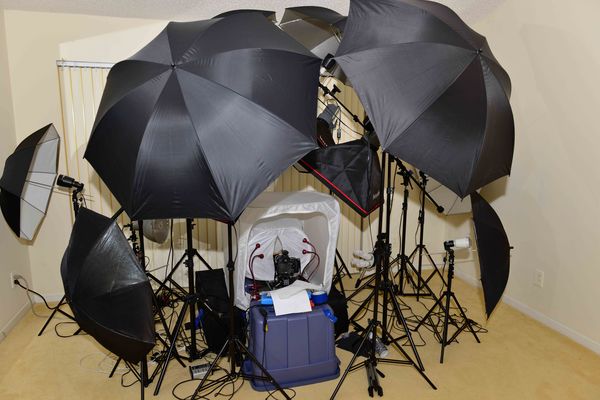
(Download)
Camera/lens and focus stacking rails in inner tent
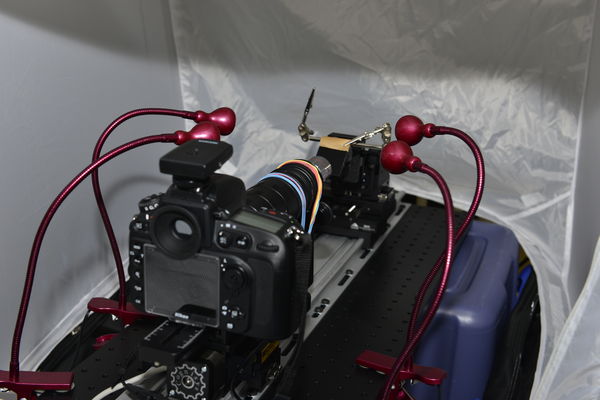
(Download)
Subject chip on black plastic and 3 axis positioner
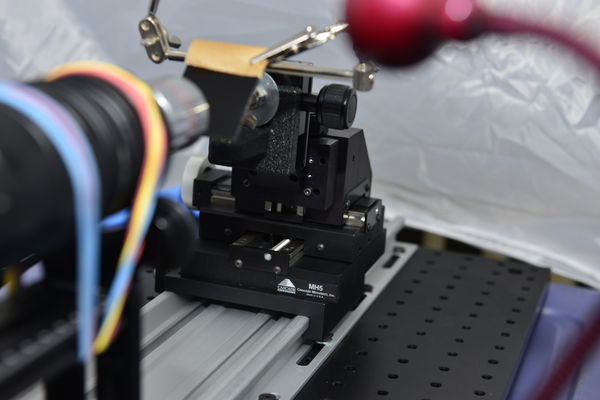
(Download)
Jan 9, 2016 13:13:01 #
Outside the 4 main strobes in soft boxes, the microscope objective, D800 and focus rails, everything else is cheap eBay stuff mostly from Hong Kong and China. So this didn't cost as much as many might think, and it's not due to GAS as mentioned before. Everything has a purpose and contributes to the final result.
The first image below was taken with this lighting setup, it's is highly cropped (to remove some proprietary details) and very low resolution, the solder balls are 40 microns in diameter. The second image is also very low resolution, this was done with and earlier setup similar to the one shown except it used a 42mm dis lens system (note the vignetting), the first image was done with a later designed 52mm lens. The gold wire bonds are 24 microns wide.
The first image below was taken with this lighting setup, it's is highly cropped (to remove some proprietary details) and very low resolution, the solder balls are 40 microns in diameter. The second image is also very low resolution, this was done with and earlier setup similar to the one shown except it used a 42mm dis lens system (note the vignetting), the first image was done with a later designed 52mm lens. The gold wire bonds are 24 microns wide.
Major Crop & Low Resolution 40um Solder Balls
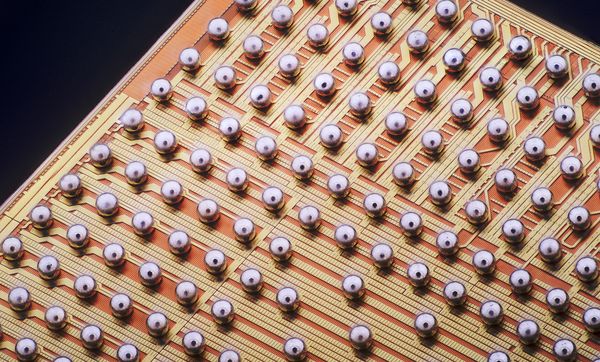
(Download)
Low Resolution Similar Setup with 42mm Lens
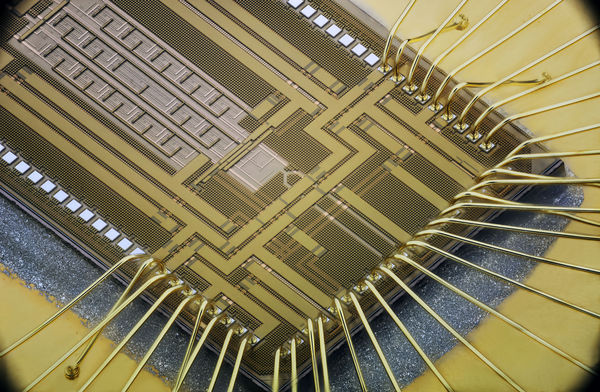
(Download)
Jan 9, 2016 14:55:14 #
mawyatt wrote:
These are amazing.The first image below was taken with this lighting setup . . .
The second image is also very low resolution, this was done with an earlier setup . . .
The second image is also very low resolution, this was done with an earlier setup . . .
Jan 9, 2016 14:57:56 #
Here are some low resolution images with earlier lighting setups, these helped progress to what I have now. If you look closely you can see some of the lighting artifacts in the tiny solder balls, which act as spherical mirrors (100 microns). Although the overall wide metal traces (gold color, but actually aluminum with a very thin layer of polyimide on top, called passivation), look OK and seem properly exposed (this is where I discovered the JPEG banding issues long ago), the solder balls revel a different view, note the tiny bright reflections in the balls. In the second this si better, but note the damage on the mid right side due my tweezers...well actually due to my mishandling :oops:. The next to last is a highly cropped image of the 100 micron solder ball in a later lighting setup with better uniform illumination, the last a highly cropped 40 micron solder ball in the latest setup. All images are very low resolution, the slight dimples in the solder balls top are due to our wafer scale probing to evaluate these chips while they are still part of a 8 inch diameter silicon wafer. Later they a cut apart into individual chips like these shown here.
Earlier lighting setup, note tiny spherical solder balls
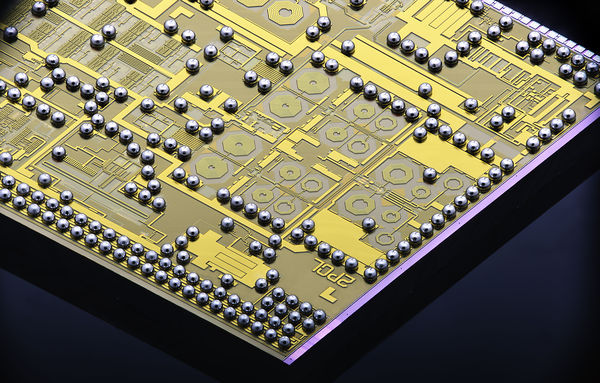
(Download)
Slightly better lighting setup, note chip edge damage on right
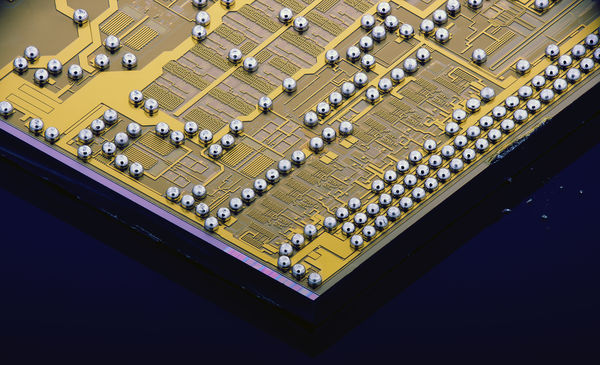
(Download)
Large crop of solder ball on later lighting setup
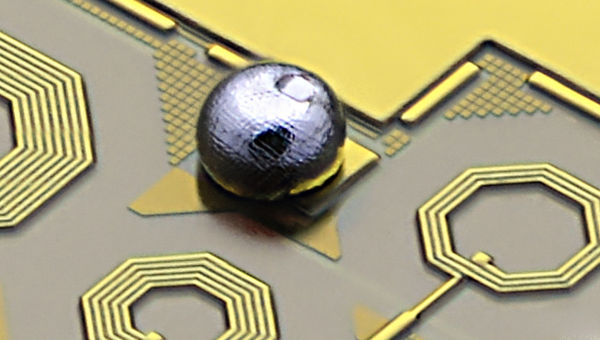
(Download)
Another large crop, 40 micron solder ball on latest setup
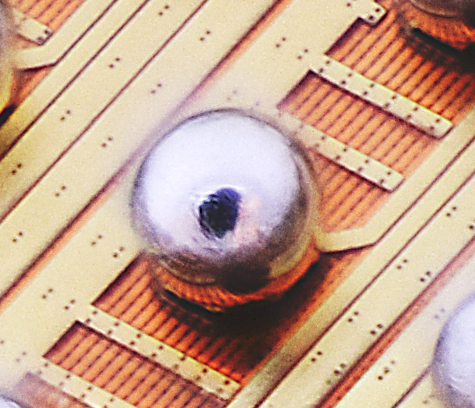
Jan 9, 2016 15:35:45 #
LoneRangeFinder wrote:
Thanks. I am hoping these will help others involved in this type of imaging. The lighting setup is quite critical, much more so than other subjects. Simple diffusion techniques just don't yield the results I am looking for, so extreme measures are required. Same goes for vibration, it must be dealt with from every source imaginable. I tried to stop the earth's rotation while doing my stacks, but she wouldn't cooperate :)These are amazing.
Jan 9, 2016 17:34:23 #
Very impressive. That's one sweet rig. So that's not a reversed Raynox on your tube lens? You mention a special 52mm? Trade secret? LOL!
Jan 9, 2016 17:50:54 #
mawyatt wrote:
Mike--well obviously you've put a lot of thought and effort into your set-up. I'm curious if you use wood as a dampening material for vibration.I am hoping these will help others involved in this type of imaging. The lighting setup is quite critical, much more so than other subjects. Simple diffusion techniques just don't yield the results I am looking for, so extreme measures are required. Same goes for vibration, it must be dealt with from every source imaginable. I tried to stop the earth's rotation while doing my stacks, but she wouldn't cooperate
Jan 9, 2016 18:43:19 #
If you want to reply, then register here. Registration is free and your account is created instantly, so you can post right away.





